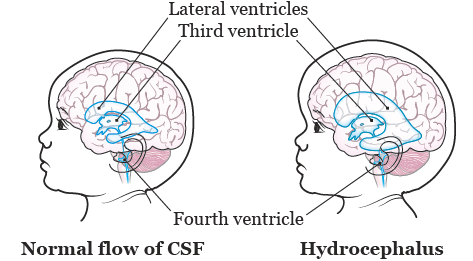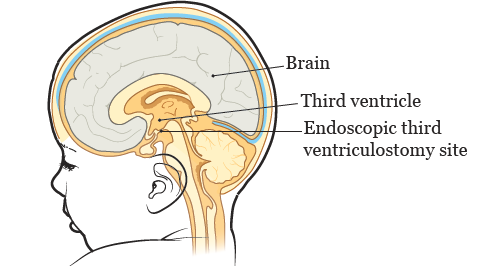This information will help you learn about your endoscopic third ventriculostomy (ETV). In this resource, the words “you” and “your” refer to you or your child.
ETV is a surgery to drain extra cerebrospinal fluid (CSF) from your brain. CSF is a liquid that’s made in the ventricles (hollow spaces) in your brain. Your CSF protects your brain and spinal cord by acting like a cushion. It also brings nutrients throughout your brain and carries waste away. You’re making new CSF all the time.
Normally, CSF flows from your ventricles, around your brain and spinal cord, and into your bloodstream. Hydrocephalus (HY-droh-SEH-fuh-lus) happens when CSF builds up in your ventricles. This makes your ventricles bigger and puts pressure on your brain (see Figure 1).

Hydrocephalus can happen if the flow of CSF is blocked or if not enough CSF is absorbed into your bloodstream.
About Your ETV Surgery
Your ETV surgery will be done in the operating room while you’re asleep. Once you’re asleep, a surgical nurse will shave the hair along your incision (surgical cut) line. Your entire head won’t be shaved.
During your surgery, your neurosurgeon will make a tiny hole in the third ventricle of your brain. This will let the extra CSF drain into another area of your brain to be absorbed (see Figure 2).

For more information about your ETV surgery, read the resource About Your Endoscopic Third Ventriculostomy (ETV) Surgery for Pediatric Patients (www.mskcc.org/pe/etv_surgery_peds).
Precautions After Your ETV Surgery
MedicAlert® jewelry
You should always wear a MedicAlert bracelet or necklace that says you have hydrocephalus with an ETV. If you’re ever seriously ill or hurt and need medical help, it will tell emergency services workers about your ETV.
You can buy a MedicAlert bracelet or necklace at most drug stores. For more information, visit the MedicAlert website at www.medicalert.org.
Wallet card
Your nurse will give you a wallet card that states you have hydrocephalus with an ETV. Carry the card with you at all times. If you need emergency medical care, show it to the medical workers.
Physical activities
You don’t need to take any precautions for physical activities or exercise. You can go back to doing all your usual activities after your surgery.
Wear a helmet to lower your risk of head injury, if needed. Ask your neurosurgeon for specific guidelines on wearing a helmet.
Imaging scans
You don’t need to take any precautions if you have an imaging scan (such as a magnetic resonance imaging (MRI), computed tomography (CT), or x-ray scan).
When to Call Your Healthcare Provider
Call your healthcare provider if you have:
- Increased head size and bulging soft spot in infants
- A headache that doesn’t get better after resting or taking medication
- Vomiting (throwing up) with little or no nausea (feeling like you’re going to throw up)
- Fatigue (feeling unusually tired or weak)
- Irritability (becoming easily frustrated or annoyed)
- Personality changes (not acting like your normal self)
- Problems with thinking and memory (such as confusion)
- Trouble with balance or walking
- Trouble waking up or staying awake
- Weak bladder control
- Seizures
- High pitched cry in infants
- Trouble eating
- Problems seeing, such as:
- Blurred vision
- Double vision
- Vision loss
- Eyes that turn downward (also called sunsetting)
These warning signs can appear quickly. If your child has any of these signs or symptoms, call their healthcare provider right away.
If you can’t wake your child, call 911 or go to the nearest emergency room right away.